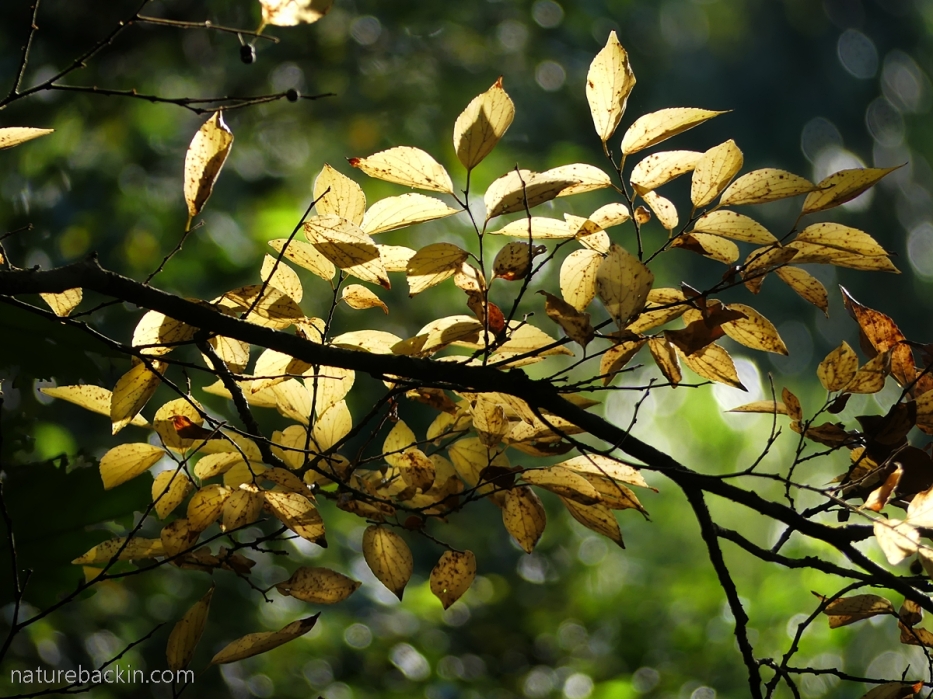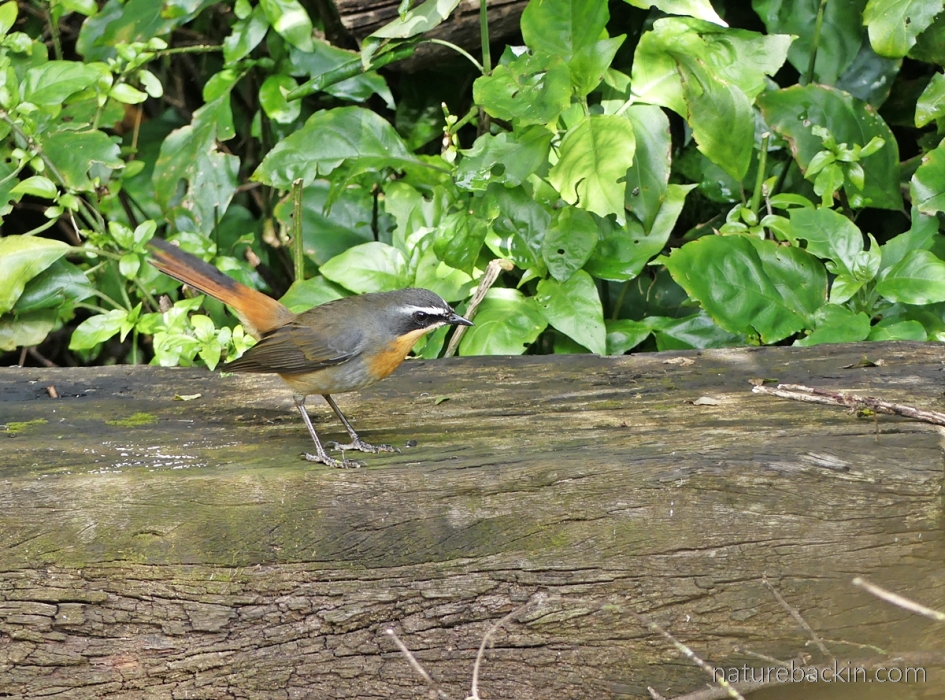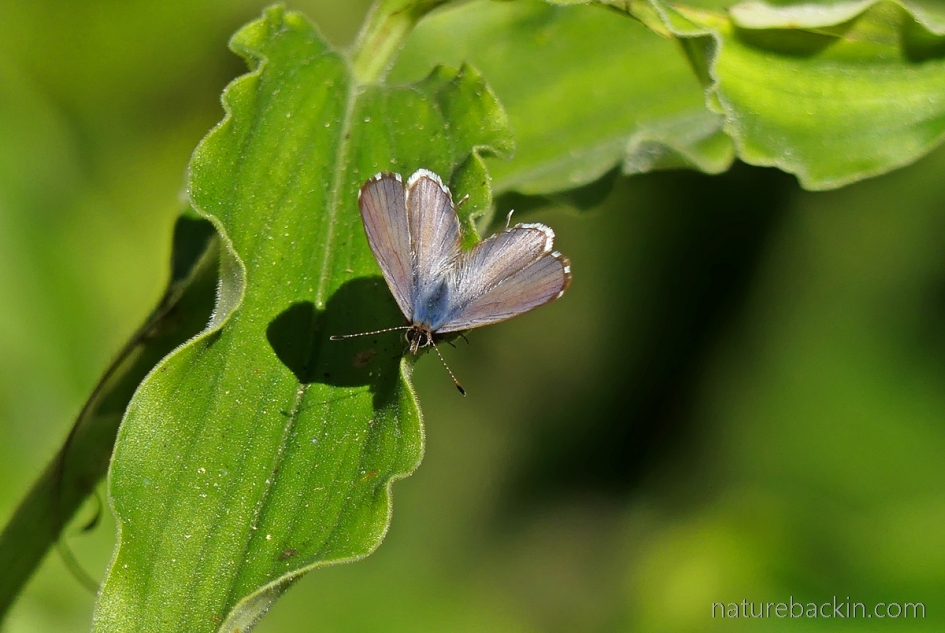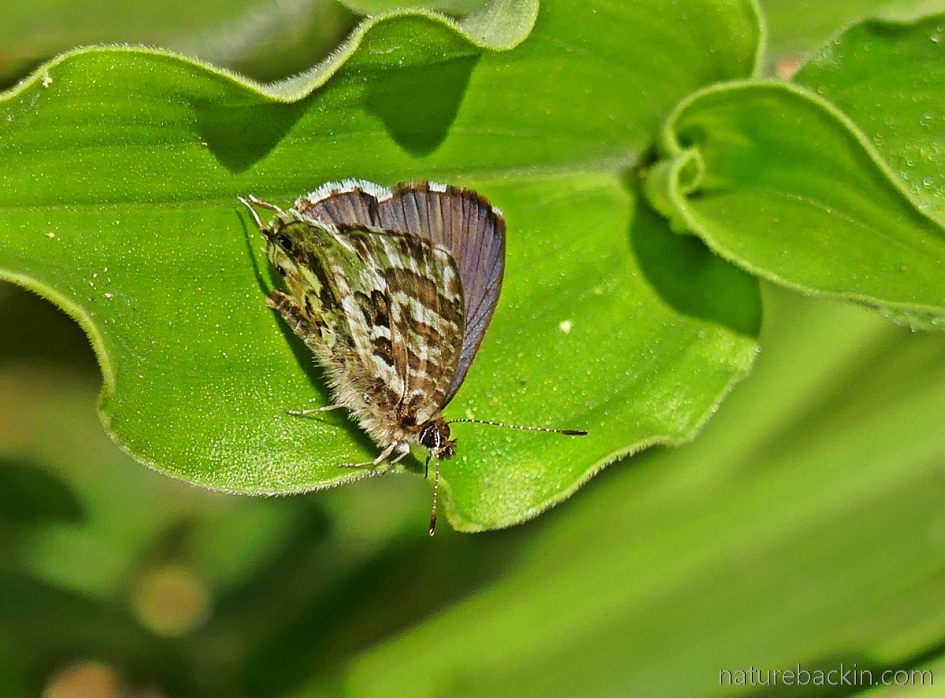On mini walking safaris around our suburban garden here in KwaZulu-Natal I often take my camera with me as invariably I find something worth a second look. Here are some pics of a few of our visitors taken during the months of autumn into winter
Although I seem to be seeing fewer and a smaller variety of insects in the garden over the last few years we are still blessed with interesting insect visitors. They all have their place in the local ecology; for instance, many are pollinators, the larvae of some insect species parasitize other species of insects, and many insects are themselves food for birds and other animals.

This visiting bee-fly I found fascinating. It was tiny and wary so I had to push my camera to get this photo from a distance of the fly perching on a flower of a perennial basil plant. A bee-fly is able to hover while it accurately inserts its long proboscis into a flower while feeding. Bee-flies are important pollinators and their larvae parasitize a variety of other insect species. Amazingly, there are about 940 species of bee-flies (in the Bombyliidae family) in southern Africa.

I was charmed to see this cloudy forester butterfly (Tagiades flesus) nectaring from purple broom (Polygala virgata) flowers. The white underside of the butterfly is rather surprising.

Above is a handsome paper wasp that I saw warming up in morning sunshine on the leaf of an aloe plant. At one point it seemed to be licking moisture off the leaf and then it stopped to preen its antennae before flying off. Paper wasps are classed in the subfamily Polistinae. Being nectar feeders the adults play a role as pollinators. They feed their young on chewed-up caterpillars and so they also play a role in controlling caterpillar populations. When unmolested, including around their nests, we have not found these wasps to be aggressive, and their accomplishments as pollinators and pest-control agents are to be valued.

During early autumn, when taking our dogs for their customary late afternoon wander around the garden, for a few weeks almost every day we saw this juvenile ashy flycatcher (Muscicapa caerulescens) perching most confidingly in the branches of a dead tree. Sometimes, rather inexplicably it appeared to approach us as if expecting us to feed it.

Happily though, the parents were on hand to feed the youngster, and for several weeks at least one of them was around to watch us take our walk every evening. The adults too became very tame. Unfortunately though, the late afternoon/early evening autumnal light was so dim that it made photography a bit tricky.

By contrast, the black-backed puffbacks (Dryoscopus cubla) prefer to stay mostly up in the tree canopy and so are much harder to see. However, the other day I spotted this male black-backed puffback scratching around on the bark of a tree, removing bits of bark as presumably he was finding insects or spiders concealed underneath. The name puffback comes from the territorial display during the breeding season of male black-backed puffbacks who puff up their back and rump feathers into a conspicuous white puffy ball.

Along with birds such as the puffbacks, in the margins of our mini-woodland I quite often see leopard butterflies. The one in the photo above is quite tatty with a piece missing from the left hindwing and the edges being a bit frayed. I think that this is an African leopard (Phalanta phalantha aethiopica), but it might also be the similar forest leopard (Phalanta eurytis).

Near our small garden pond I photographed this damselfly. In the bright sunlight the pale blue colouration appears bleached. I spent some time with my insect guidebook trying to ID the damselfly but I think discretion is wisest here rather than hazarding a guess.

At our garden pond I spotted this honey bee seeking pollen from a flowering Nymphoides thunbergiana. This plant is known as floating hearts, referring to the shape of the leaves, and also as the fairy water lily, although strictly speaking it is not a water lily at all.

Also attracted to the pond was this dead-leaf (eared) commodore butterfly (Precis tugela tugela). I managed to sneak up on it as it perched on some water plants from where it took a drink of water.
Much of this autumn/winter activity – be it pollinating insects going about their business or birds visiting the birdbaths – takes place once the temperature has warmed up and the sun is relatively high, so there is little chance of golden-hour photography to capture these visitors or behaviours.

Another case in point is this dark-backed weaver (Ploceus bicolor) that visited the birdbath at midday when there was strong contrast between bright sunlight and shade. These weavers, formerly known as forest weavers, bathe with great energy submersing almost entirely while shaking their bodies and wings splashily.

The dark-backed weaver was most annoyed to have its bathing interrupted by the arrival of an unwitting thick-billed weaver (Amblyospiza albifrons ) who in the end decided not to hold its ground and so left the dark-backed weaver to carry on with its bath. Unfortunately the bright sunshine whited-outs parts of the photo, but I thought the encounter interesting enough to include this pic anyway.

Early in June I was delighted to discover that a black-legged golden orb spider (Nephila finestra) had spun her web between two shrubs near our house. It is a long-time since I have seen one of the larger golden orb spiders in our neighbourhood. When I was a child they were quite common. The name golden orb refers to the golden colour and orb shape of the web. I went to admire the spider and her web every morning, but after her being around for only about a week one morning I was disappointed to find her gone with a large gaping hole in the centre of the web. I assume she had been caught by a bird or perhaps even by a bat.

Early winter this year has been unusually cold by our standards, with night-time temperatures dropping to 3 or 4 °C (5 to 7 °F) in recent weeks and with snow on the Drakensberg Mountains. As a result the leaves of the deciduous white stinkwood (Celtis africana) trees started turning in colour and dropping their leaves early in the winter. Usually in our relatively mild winters they drop their leaves later in the season as they are only briefly leafless before the early spring. The photo above was taken in late April.

Even when the nights are relatively cold, some of the days have been warm with temperatures in the low to mid-twenties Celsius (around 40° Fahrenheit). One afternoon I was walking past a flowerbed and happened to notice this eastern green snake (Philothamnus natalensis) suspended in a shrub absorbing the heat of the sun. I went and got my camera and when I got back it was a bit unsettled at having been spotted and so it slowly moved off. I was sorry to have disturbed it.

Another reptile in our garden – much tamer than the snake – is the eastern striped skink (Trachylepis striata). Like all reptiles the skinks need to warm up in the sunshine when possible and they spend a lot of time in winter sun-basking. Do you see the two baby skinks left and right at the top of the photo above the comparatively large adult? Eastern striped skinks give birth to live young, although some skinks lay eggs.

Also enjoying the sunshine was this hadeda ibis (Bostrychia hagedash) that I photographed while it was preening on the roof of the house. The sunshine shows up the lovely iridescence of the feathers.

Around the months of April and May the pigeon wood trees (Trema orientalis) are fruiting. Vervet monkeys and many birds are attracted by the berries, including this Cape white-eye (Zosterops capensis) that was flitting about in the tree pausing to reach up to pluck off berries.

Often seen in our garden are Cape robin chats (Cossypha caffra). Usually we see them on their own but sometimes in pairs and occasionally we see a parent feeding a juvenile. They are very active birds and often seen foraging for prey on the ground, sometimes stopping to flick the tail up to a jaunty angle as seen in the photo above.

Another regular presence in the garden is that of the common bush brown butterflies (Bicyclus safitza safitza). They are easier to photograph than most butterflies as they are more tolerant of being approached when they are settled in a sunny spot.

Another sighting in bright sunlight was of a small skipper-type butterfly that I think is in fact a dart butterly – likely a male Mackin’s dart butterfly (Acleros mackenii). It is warming itself up while perching on a flower of a giant salvia (Brilliantaisia subulugurica), a plant that occurs naturally further north in Zimbabwe and tropical Africa.

This unusually vivid sunrise, photographed in mid-June from our bedroom window, is a bit of a random feature in this collection but pleasing enough to be included anyway. Some aloe flowers can be seen in silhouette against the sky.

And back to butterflies – one of the small zebra blue butterflies decided to pause from flitting from plant to plant and flower to flower to sunbathe briefly, allowing me to appreciate the lovely blue sheen on the upper wings.

And here it is again with wings partially closed showing the intricate patterning of the underwings. I guess this is likely to be a common zebra blue (Leptotes pirithous). These butterflies lay their eggs on Plumbago or Fabaceae, the latter being the pea, bean and legume family of plants.

Meanwhile back at the birdbath a terrestrial brownbul (Phyllastrephus terrestris ) took a drink before indulging in its characteristic plunge style of bathing. These birds are more usually heard than seen as they rustle through fallen leaves in the understorey of woodlands often uttering repetitive chattering contact calls as they forage together in small groups.

Even more gregarious are the bronze mannikins (Lonchura cucullata) seen here bathing together on another sunny morning. What better way for us humans to enjoy a morning coffee than soaking up some sunshine while watching all the action at one of the birdbaths?

A shadow play of white stinkwood (Celtis africana) leaves on the fence between us and our neighbours.
In the midst of all that is going in this world of ours, I hope you too find the time and opportunity to observe the signs of life in your neighbourhood whatever they may be. I recall when I lived in a high-rise apartment area of Johannesburg many years ago, I had to find solace in feral pigeons and house sparrows that visited the street trees below my balcony, in the orange sunsets in polluted skies, and in the few pot plants that managed to survive in my flat that got very little direct sunlight.
Posted by Carol









July 24, 2022 at 10:57 pm
I love your “tours”! It is amazing to see how much is within your reach. I especially enjoy those “random” photos that you put in, as it gives me a better sense of your surroundings in general. Hope you are well!
LikeLiked by 1 person
August 12, 2022 at 9:49 am
Hi Julie – I am reconnecting at long last! Thanks so much for visiting my post and its nice to know the ‘random’ pics have their place. All is well, I have just been a bit scattered of late. I hope that you are well too. Best from KZN.
LikeLike
July 23, 2022 at 1:33 pm
It was a total joy to meander around your garden with you, Carol, enjoying the beauties of nature that surround you. Your descriptions were serene while we enjoyed the liveliness of your nature friends. As a birder who loves Africa, I felt like I was visiting some of my old friends again, very fun. And I smiled at the hadeda ibis, remembering some of the early morning cacophony of their flocks. I loved being so intimate here with the butterflies and bird bathers, and your reverence for all the beauty and life that surrounds you was especially appreciated.
LikeLiked by 1 person
July 23, 2022 at 7:14 pm
Hi Jet – how nice that you shared in my rambles around the garden. Hadedas definitely make an impression and I am one of those who finds them a delight (there are those who regard them as a nuisance). As I think you do too, I always hope that more people take pleasure in the nature they find around them and recognize how special even familiar creatures are!
LikeLiked by 1 person
July 24, 2022 at 3:28 pm
Yes, you and I agree, Carol, on the joys and pleasures of nature and recognizing and embracing the beauties that surround us wherever we are. I loved hearing the hadedas, and when I left I missed them. Salutes and smiles to you and SA….
LikeLiked by 1 person
August 12, 2022 at 9:52 am
Thanks so much Jet. Sorry about the delay in replying but best greetings to you too, and from the hadedas as well!
LikeLiked by 1 person
July 17, 2022 at 1:26 pm
Such a wealth of observation, Carol, in your amazing garden.
LikeLiked by 1 person
July 19, 2022 at 8:02 pm
Thanks Christine. Our garden is certainly very rewarding.
LikeLike
July 17, 2022 at 5:34 am
We seem to have less pollinators lately, though we’ve worked at introducing more native flowering plants.
Your photos of the flycatcher were delightful despite the challenging lighting. Thankfully you had better lighting for that beautiful shot of the Ibis!
I never cease to be thrilled to see the different flora and fauna you have on your side of the world… not to mention your opposite seasons.
And I think your robin is far cuter than our version!
I’m glad you included that amazing sunset!
Thank you for sharing your “signs of life”. I wondered if you had always lived in your lovely neighborhood, but it seems we share a delightful move to a more natural setting. Thank heavens given what we’ve been through these past years!
LikeLiked by 1 person
July 19, 2022 at 8:02 pm
Thanks Gunta. I hope that seeing fewer insects means that they are elsewhere and not actually diminishing, although of course there are lots of reasons why that might very sadly be the case.
I think your robin is more truly a thrush, and ours is more truly a chat!
I have lived in quite a few places, but I spent my childhood in one place that strangely enough is in the house next door to where I live now!
LikeLiked by 1 person
July 23, 2022 at 5:27 pm
Funny, how bird, animal and plant names can change from one continent to the next. It even happens regionally. When I moved to Oregon, I discovered that the local name for a Flicker (https://www.gettyimages.com/photos/northern-flicker) was Mountain Robin.
As for insects… now that we have more flowers blooming, it seems the insect and pollinator population has improved somewhat. It seems to be keeping the birds happy with lots of new feathered youngsters being kept fed! (yay!)
LikeLiked by 1 person
August 12, 2022 at 9:54 am
Hi Gunta – sorry about the long delay – the northern flicker is a handsome bird indeed. How odd for a woodpecker to be called a mountain robin!
Yes pollinators are an important link up and down the food chain!
LikeLiked by 1 person
July 13, 2022 at 10:35 am
What a wonderfully diverse garden you have, brilliantly captured by your photos.
LikeLiked by 1 person
July 19, 2022 at 7:47 pm
Thank you very much. I have just popped over to visit your blog and will definitely be back. I apologize for having taken so long to respond to your comment.
LikeLiked by 1 person
July 12, 2022 at 3:02 pm
What abundance! Thank you for the beautiful photographs and instructive tour around your garden. Your knowledge of is astounding
LikeLiked by 1 person
July 19, 2022 at 7:35 pm
Thanks Mariss. I understand why Ferdinand the Bull liked to sit under a tree and smell the flowers 🙂
LikeLiked by 1 person
July 12, 2022 at 5:50 am
I have been out of contact for a while now and have opened my computer for the first time in a week: what a pleasurable tour of your garden. Your photographs and descriptions are balm to the soul.
LikeLiked by 1 person
July 19, 2022 at 7:27 pm
Thanks Anne. I have also not been able to attend to blogging as much as I would like to. I hope all is well with you.
LikeLiked by 1 person
July 10, 2022 at 9:42 pm
What a fantastic collection of garden creatures you have, Carol. I envy the variety. At times we do have a nice population of different species here but at others there is quite a dearth. Our neighbor is a lawn nut (putting that kindly) and he is responsible in my eyes for reducing the number of insect species in my yard by his quest for the perfect lawn. Insects and birds don’t care about property lines.
Thanks for sharing your garden walks, Carol!
LikeLiked by 1 person
July 18, 2022 at 7:35 pm
Thanks yes we are fortunate although I do think there has been a decline in insect diversity and numbers over the years in our neighbourhood. So sorry about the lawn nut neighbour.
LikeLiked by 1 person
July 18, 2022 at 8:49 pm
Fortunately he is thinking of moving in a year or two as he and his wife are in their eighties and ready for senior living. I just hope that the next owners want something more natural and at that it will take years to repair the harm he has done.
LikeLiked by 1 person
July 19, 2022 at 7:25 pm
Here’s hoping the next owner is more nature aware and nature friendly. It is sad when people aren’t prepared to even consider more natural approaches to their gardens.
LikeLiked by 1 person
July 9, 2022 at 11:41 pm
What a wonderfully diverse array of wildlife, Carol! I really enjoyed seeing your remarkable shots of insects, and so many of your birds which are species related to – but different from – ours!
LikeLiked by 1 person
July 10, 2022 at 6:01 pm
Thank you Carol. It is lovely to find insects that are large enough (and still enough) to photograph. I enjoy seeing your north American birds for similar reasons – interesting differences between related species, kind of like variations on a theme!
LikeLiked by 1 person
July 9, 2022 at 9:41 am
Carol, another wonderful post. Such richness is always under our noses if we stop to look but few of us can capture it so well as you. And yes – a very welcome distraction from events in the wider world. As we begin what is forecast to be a stretch of very warm weather, I shall pay particular attention to the life in our garden today.
LikeLiked by 1 person
July 10, 2022 at 5:57 pm
Thanks so much Sandra. I hope your warm weather doesn’t end up being unpleasantly warm, and that you came across some lovely little treasures and distractions in the garden.
LikeLiked by 1 person
July 9, 2022 at 8:22 am
You get such fantastic photos – what patience! I particularly have enjoyed your various insect shots. Though who could resist the bronze mannikins bathing?
LikeLiked by 1 person
July 10, 2022 at 5:53 pm
Thanks Margaret. I am pleased to hear you liked the insects. The mannikins group bathing sessions are great fun to observe.
LikeLiked by 1 person
July 9, 2022 at 4:27 am
What wonderful variety you can find in your neighborhood. Thank you for sharing the bounty. The commodore is spectacular.
LikeLiked by 1 person
July 10, 2022 at 5:50 pm
Thanks Tanja. Yes that commodore is an especially beautiful butterfly.
LikeLiked by 1 person
July 8, 2022 at 4:22 am
Lovely photos from your garden, Carol. The bee-fly is fascinating and the bathing weaver entertaining, and I love snakes so always appreciate photos of them!
LikeLiked by 1 person
July 8, 2022 at 8:50 pm
Thanks Graham. Yes that little furry bee-fly I also found fascinating. Glad you like snakes especially as not many people do. The dark-backed weavers have quite an assertive manner about them – even when not having a standoff with other birds.
LikeLiked by 1 person
July 8, 2022 at 3:44 am
Such a heart warming blog Carol, thank you! We too have had the black-backed puffback here these past few months, I love the attitude and bright orange eyes. The male has been defending his territory, attacking his reflected image in the window panes! xxx
LikeLiked by 1 person
July 8, 2022 at 8:48 pm
Thanks Christeen. The puffbacks do have an intensity about them. I always feel sorry when birds think they have to fight off their reflections. I remember on a camping trip in Botswana some birds were bothered by their reflection in the wing mirrors on our vehicle, so we hung tea towels over the mirrors to give the birds a break!
LikeLiked by 1 person
July 8, 2022 at 2:50 am
The diversity in your garden is amazing, Carol!
Obviously a reward for your carefully considered gardening along with nature instead of against it.
And your skill with a camera cannot go unmentioned!
LikeLiked by 1 person
July 8, 2022 at 8:44 pm
Thanks very much for your kind comment.
We have a kind of ‘go with the flow’ style of gardening 🙂 It is easy as well as rewarding!
LikeLiked by 1 person
July 7, 2022 at 10:15 pm
Thoroughly enjoyable visit to your garden, Carol. If not for nature, I think we’d be a tad more insane than we already are! 😉 Hope those cold temps aren’t causing permanent damage to your plants. It is amazing that the insects and plants can survive those low temps!
LikeLiked by 1 person
July 8, 2022 at 8:40 pm
I agree that nature does help us to try to stay sane!
Of course our ‘low’ temps don’t come close to yours! We have not had any frost and the plants survive well, so far at least – some plants go dormant in winter, but its hard to tell how the insects manage.
LikeLike
July 7, 2022 at 9:52 pm
It’s wonderful to see and learn about local plants and wildlife in another part of the world that I haven’t seen before. A beautiful sunrise and the shadow play image is lovely. Thank you Carol.
Laura
LikeLiked by 1 person
July 8, 2022 at 8:37 pm
Thanks so much Laura. The sunrise was exceptional and I am glad you like the shadow play image.
LikeLiked by 1 person
July 7, 2022 at 8:31 pm
I thoroughly enjoyed coming along on your tour, Carol!
LikeLiked by 1 person
July 8, 2022 at 8:36 pm
Thanks for joining the tour Sandy 🙂
LikeLiked by 1 person
July 8, 2022 at 11:35 pm
My pleasure.
LikeLiked by 1 person
July 7, 2022 at 7:17 pm
Ah, that Puffback!
I have seen this bird just once in all the years we have lived here in Observatory.
LikeLiked by 1 person
July 8, 2022 at 8:36 pm
I have found it surprising how difficult it can be to spot them even when I know they are around.
LikeLiked by 1 person